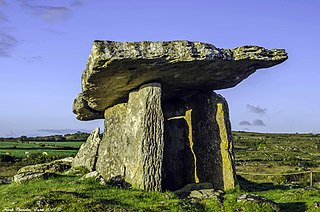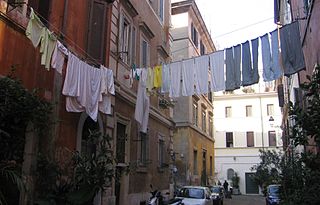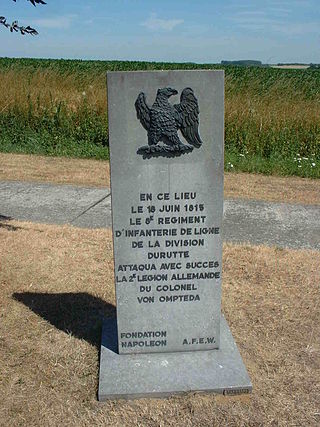

A stone slab is a big stone, flat and relatively thin, often of rectangular or almost rectangular form. They are generally used for paving floors, for covering walls or as headstones. [1]


A stone slab is a big stone, flat and relatively thin, often of rectangular or almost rectangular form. They are generally used for paving floors, for covering walls or as headstones. [1]
Most dolmen constructions were built using stone slabs of big dimensions. Their architecture often includes a corridor of access that can be constructed using stone slabs or dry stones. The burial chamber, with variable shapes (e.g. rectangular, polygonal, oval, circular) can also be preceded by an anteroom. In some dolmens, the entrance has a door cut into one or more vertical stone slabs. [2] [3]

The main applications of the slabs as material of construction are for pavings and in the construction of roofs. They can be employed for other uses, among them:
One system of cooking is cooking "to the slab". [4] Similar to the systems of "to the iron" or "grilled", in the procedure to bake to the slab the foods (e.g. meat, fish, vegetables) are put on a slab heated on a fire with oil, butter or lard and other garnishings. [5]

From prehistoric times there have been examples of graves covered with a stone slab, in its natural state or carved. This use of slabs as tombstone has extended the concept of natural slab to the tombstone variant: flat, thin and polished. An instance is the slab in the tomb of King Pere el Gran of Aragon, which weighs 900 kg. [8]
Such tombstones usually have inscriptions. This traditionally includes the name of the deceased, date of birth and/or death. The inscriptions are generally on a frontal side but also in some cases in the verso (on the top side) and around the edges. Some families commission or make an inscription on the underside. Some also have epitaphs: in praise (eulogies); citations of religious texts, such as "Requiescat in pace"; sentiments or quotations. [9]
A pyramidal or "hipped" stone slab, sometimes surmounting another base or fuller sarcophagus is a design seen across all continents as most organic debris will fall off of this and overgrowth from moss, grass and akin lowest-level plants. Examples are the graves of Sir John Whittaker Ellis and of the 1st Baron Cozens-Hardy.

Washing clothes is a basic need in civilised societies and, in general, in all the parts of the world. In primitive periods—before running water, washing machines and detergents—it was necessary to go to wash the clothes to the river bank or in a laundry room.
Clothes were washed manually, by rubbing and sometimes striking them against a hard surface with soap. The aim was to do penetrate the mix of water and soap between the fibres of the fabric to pull-out the dirt. The slabs to wash the clothes were slabs of natural stone chosen to present a fine and relatively flat surface. The small rounded irregularities could help of friction in the washing process. [10] [11]

Hunting with slabs is a system of hunting by means of a slab-trap. The fundamental part of the device is a slab. Preparing this trap was a delicate task. [7] [13] [14]
From the term slab and its derivatives, there are many toponyms among them.

A dolmen or portal tomb is a type of single-chamber megalithic tomb, usually consisting of two or more upright megaliths supporting a large flat horizontal capstone or "table". Most date from the Late Neolithic period and were sometimes covered with earth or smaller stones to form a tumulus. Small pad-stones may be wedged between the cap and supporting stones to achieve a level appearance. In many instances, the covering has eroded away, leaving only the stone "skeleton".

Laundry refers to the washing of clothing and other textiles, and, more broadly, their drying and ironing as well. Laundry has been part of history since humans began to wear clothes, so the methods by which different cultures have dealt with this universal human need are of interest to several branches of scholarship.

A headstone, tombstone, or gravestone is a stele or marker, usually stone, that is placed over a grave. It is traditional for burials in the Christian, Jewish, and Muslim religions, among others. In most cases, it has the deceased's name, date of birth, and date of death inscribed on it, along with a personal message, or prayer, but may contain pieces of funerary art, especially details in stone relief. In many parts of Europe, insetting a photograph of the deceased in a frame is very common.

A stele, or occasionally stela, when derived from Latin, is a stone or wooden slab, generally taller than it is wide, erected in the ancient world as a monument. The surface of the stele often has text, ornamentation, or both. These may be inscribed, carved in relief, or painted.

Biscotti, known also as cantucci, are Italian almond biscuits that originated in the Tuscan city of Prato. They are twice-baked, oblong-shaped, dry, crunchy, and may be dipped in a drink, traditionally Vin Santo.

Acrylic fibers are synthetic fibers made from a polymer (polyacrylonitrile) with an average molecular weight of ~100,000, about 1900 monomer units. For a fiber to be called "acrylic" in the US, the polymer must contain at least 85% acrylonitrile monomer. Typical comonomers are vinyl acetate or methyl acrylate. DuPont created the first acrylic fibers in 1941 and trademarked them under the name Orlon. It was first developed in the mid-1940s but was not produced in large quantities until the 1950s. Strong and warm acrylic fiber is often used for sweaters and tracksuits and as linings for boots and gloves, as well as in furnishing fabrics and carpets. It is manufactured as a filament, then cut into short staple lengths similar to wool hairs, and spun into yarn.

Calçot is a type of green onion. The name calçot comes from the Catalan language. The calçot from Valls is a registered EU Protected Geographical Indication.

Concentrations of megaliths, dolmens and stone labyrinths dating between the end of the 4th millennium and the beginning of the 2nd millennium B.C. have been found throughout the Caucasus Mountains, including Abkhazia. Most of them are represented by rectangular structures made of stone slabs or cut in rocks with holes in their facade. These dolmens cover the Western Caucasus on both sides of the mountain ridge, in an area of approximately 12,000 square kilometres of Russia and Abkhazia.

The dolmens of Jersey are neolithic sites, including dolmens, in Jersey. They range over a wide period, from around 4800 BC to 2250 BC, these dates covering the periods roughly designated as Neolithic, or “new stone age”, to Chalcolithic, or “copper age”.

Stone washing is a textile manufacturing process used to give a newly manufactured cloth garment a worn appearance. The process became popular in the 1980s, as acid jeans gained popularity, however stone washing has roots going back to 1960s surfer apparel. Stone-washing also helps to increase the softness and flexibility of otherwise stiff and rigid fabrics such as canvas and denim. Although stone washing increases a fabric's flexibility, it shortens the life-span of the jeans. The process of Stone Washing can be costly, as freshly stone washed jeans must be washed many times in order to remove the grit from the process. Along with high production costs, stone washing can be detrimental to the environment, due to the excess grit that is removed as fabric is being stone washed. This leads many manufacturers to pursue other methods to achieve a distressed appearance.

The Tumulus of Bougon or Necropolis of Bougon is a group of five Neolithic barrows located in Bougon, near La-Mothe-Saint-Héray, between Exoudon and Pamproux in Nouvelle-Aquitaine, France.

A sett, also known as a block or Belgian block, is a broadly rectangular quarried stone used in paving roads and walkways. Formerly in widespread use, particularly on steeper streets because setts provided horses' hooves with better grip than a smooth surface, they are now encountered rather as decorative stone paving in landscape architecture. Setts are often referred to as "cobblestones", although a sett is distinct from a cobblestone in that it is quarried or worked to a regular shape, whereas the latter is generally a small, naturally-rounded rock. Setts are usually made of granite.

The washing paddle, known as thaapi in Haryanvi and Hindi languages, is a hand tool used to do laundry. It is made of wood, shaped like a baker's peel, but with a much shorter handle used as a grip. It was used to beat the wet clothes and linens, pushing out the dirt by hammering the items against the washboard, or against the flat slabs built into the laundry area.

The Dolmen of Cunha Baixa is a dolmen in the civil parish of Cunha Baixa, in the municipality of Mangualde. It is located in a valley area of the Rio Castelo, between the villages of Cunha Baixa and Espinho.

Nordic megalith architecture is an ancient architectural style found in Northern Europe, especially Scandinavia and North Germany, that involves large slabs of stone arranged to form a structure. It emerged in northern Europe, predominantly between 3500 and 2800 BC. It was primarily a product of the Funnelbeaker culture. Between 1964 and 1974, Ewald Schuldt in Mecklenburg-Western Pomerania excavated over 100 sites of different types: simple dolmens, extended dolmens, passage graves, great dolmens, unchambered long barrows, and stone cists. In addition, there are polygonal dolmens and types that emerged later, for example, the Grabkiste and Röse. This nomenclature, which specifically derives from the German, is not used in Scandinavia where these sites are categorised by other, more general, terms, as dolmens, passage graves and stone cists.

The dolmen del prado de Lácara is a megalithic monument known as a passage tomb. It is located northwest of the Spanish city of Mérida, in the province of Badajoz. It is located next to the EX-214 road, which connects Aljucén with La Nava de Santiago. It is a notable megalithic tomb, built during the late Neolithic towards the end of the 4th millennium BC or early 3rd millennium BC. It is one of the most monumental and well preserved sites in the Extremadura region, which is why it was declared a site of cultural interest in 1912 and a National Monument in 1931.

Tholos de El Romeral, situated 2.5 kilometres (1.6 mi) north east of the town of Antequera (Andalusia), is one of the most important examples of early Bronze Age architecture in southern Europe. Tholos de El Romeral, also known as Cueva de Romeral and Dolmen de Romeral, is a megalithic burial site built circa 1800 BCE. It is one of three tombs in region, the others being Dolmen de Menga and Dolmen de Viera, both situated to the south west.

A washboard is a tool designed for hand washing clothing. With mechanized cleaning of clothing becoming more common by the end of the 20th century, the washboard has become better known for its secondary use as a musical instrument.
La Fada Morgana is a Catalan fairy tale or rondalla, first collected by Majorcan priest and author Antoni Maria Alcover. It is related to the cycle of the Animal as Bridegroom and distantly related to the Graeco-Roman myth of Cupid and Psyche, in that the heroine is forced to perform difficult tasks for a witch.